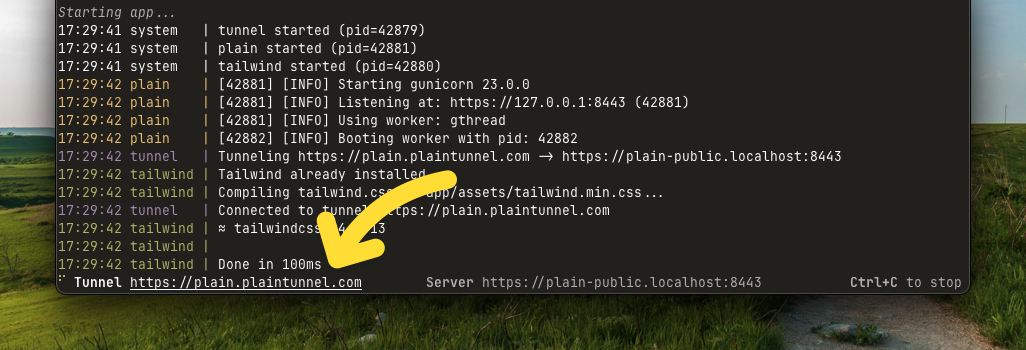plain.tunnel
Connect to your local development server remotely.
Overview
The Plain Tunnel is a hosted service, like ngrok or Cloudflare Tunnel, that is specifically designed to work with Plain and provide the minimum set of features you need to get your local development server connected to the internet. It will provision a subdomain of plaintunnel.com for you, and forward traffic to your local development server.
This is especially useful for testing webhooks, doing mobile styling on a real device, or temporarily sharing your local development URL with someone.
Basic usage:
plain tunnel https://app.localhost:8443
This will create a tunnel from a randomly generated subdomain to your local server. You can also specify a custom subdomain:
plain tunnel https://app.localhost:8443 --subdomain myappname
Usage with plain.dev
The simplest way to use plain.tunnel is to integrate it with your plain.dev configuration.
Add it to your plain.dev configuration in pyproject.toml:
[tool.plain.dev.run]
tunnel = {cmd = "plain tunnel $PLAIN_DEV_URL --subdomain myappname --quiet"}
To show a tunnel URL (whether you are using plain.tunnel or not), you can add PLAIN_DEV_TUNNEL_URL to your local .env file:
PLAIN_DEV_TUNNEL_URL=https://myappname.plaintunnel.com

CLI Usage
The cli command accepts the following options:
destination: The URL of your local development server (required)--subdomain: Custom subdomain to use (optional, auto-generated if not provided)--debug: Enable debug logging--quiet: Only log warnings and errors
Examples:
# Basic usage with auto-generated subdomain
plain tunnel https://app.localhost:8443
# With custom subdomain
plain tunnel https://app.localhost:8443 --subdomain myapp
# With debug logging
plain tunnel https://app.localhost:8443 --debug
# One-off usage without installation
uvx plain-tunnel https://app.localhost:8443
Configuration
Environment Variables
The tunnel can be configured using environment variables:
PLAIN_TUNNEL_SUBDOMAIN: Default subdomain to usePLAIN_TUNNEL_HOST: Tunnel host (defaults to plaintunnel.com)
Installation
Install the plain.tunnel package from PyPI:
uv add plain.tunnel --dev